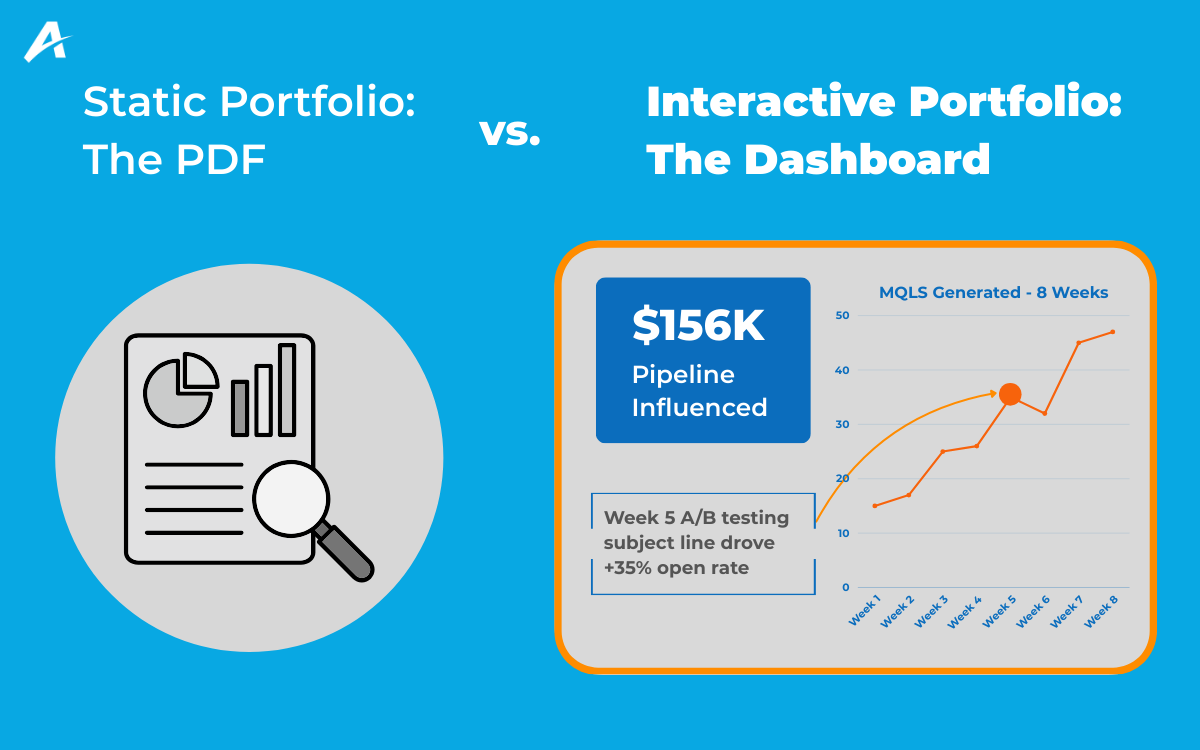
Early in my career, I shared work samples via scattered, unbranded links with zero context. When I launched Agile Marketing in 2022, I built a professional content marketing portfolio I was proud of—clean, organized, effective. But I've realized, at the end of the day, it’s a static digital brochure. It shows the work I’ve done, but it doesn’t showcase anything strategic.
So I'm practicing what I preach. This article kicks off my B2B content marketing and strategy portfolio transformation, where I'll share progress and lessons as I go.
The classic marketing consultant portfolio: headshots, PDF samples, campaign screenshots. A collection of disjointed work that reveals nothing about the strategic architecture, cross-functional collaboration, or iterative problem-solving behind each campaign. Clean, but unremarkable.
Here's the portfolio problem plaguing content marketers: Static showcases highlight creative output but ignore ROI metrics that prove strategic value. A well-known study by TheLadders found that recruiters often take as little as 6-8 seconds to decide if a resume is worth a deeper look. It's a tough reality, but you have very little time to get a recruiter's attention—make them count.
According to Gartner, 61% of B2B buyers research service providers independently before making contact. Your portfolio is your front line, determining whether you're even considered for opportunities.

The power of a professional showcase is no longer the exclusive domain of designers and developers. An interactive portfolio is the vital digital asset for every marketer ready to establish and brandish their brand authority. The key is to shift your mindset: organize your work by problem-solving methodology, not by content format. Start by answering these three key questions:
Question 1: Is your portfolio a gallery of work, or a demonstration of results? An interactive portfolio lets visitors explore the data behind business results.
Question 2: Are you presenting how you solved a problem, not just hit a number? An interactive visual lets visitors trace your strategic process from start to finish.
Question 3: Does your portfolio showcase your influence? Thought leadership is a key part of content marketing, but a list of published work links doesn't tell the full story. An interactive portfolio can turn your writing into a demonstration of your authority and influence.
The era of the passive, gallery-style portfolio is over. Today's market demands proof of impact.
Treat every portfolio project like a consulting presentation. Guide visitors through compelling narratives: lead with the business problem, walk through your strategic solution, and highlight the measurable, data-driven results you delivered. This approach transforms your portfolio into a dynamic engine for winning new business.
Ann Handley, Chief Content Officer, MarketingProfs, suggests asking deeper questions that go beyond surface-level activity:
Answering these questions requires transforming your work from a list of items into cohesive narratives.
Mindset in place? Let's build. Your portfolio's foundation isn't a scattered grid of projects; it's a collection of focused, thematic case studies.
Think of each project not as a single deliverable, but as a complete story. Each mini-case study should be a self-contained narrative that guides the viewer through your strategic process from start-to-finish. By uniting multiple assets under a single project, you prove the full scope and impact of a complete campaign.
Every thematic case study should follow a simple, powerful structure:
A case study on authority-building could combine the strategy deck, thought leadership articles, short-form videos, newsletter excerpts, conference speaking recordings, and engagement metrics dashboards.
By framing your work this way, you shift the conversation from, "Here's a checklist of deliverables I've made," to "Here's a story of how I solve business problems." This is key to demonstrating your value as a strategist, not just a creator.
Adopting the thematic case study model is the essential first step. But to truly stand out, you need to bring that story to life with modern tools and tactics. Let's dive into four strategies to master.

Transform case studies from flat documents into immersive experiences. Go beyond the static link, and embed a client video testimonial or interactive timeline that maps your strategy directly to conversion spikes. This approach proves your value and earns trust with decision-makers.
Essential Tools: Use Canva for visuals, record video explanations with Loom, and embed live Google Analytics dashboards with Google Data Studio (now Looker Studio).
Your portfolio's goal isn't just to display—it's to prove expertise. A process walkthrough elevates a flat screenshot into a dynamic view into your strategic and technical skills, turning a single deliverable into a story of innovation.
There are a few ways marketers can create walkthroughs:
Instead of a one-way showcase, turn your portfolio into a two-way dialogue. Deploy a simple chatbot to act as a personal guide, asking visitors, "What challenge are you looking to solve?"—instantly surfacing your most relevant work.
This approach isn't just a gimmick; it's a strategic response to the "digital sea of sameness" we've heard about. It's how you make waves in an ocean of identical promises. This approach transforms a passive browsing session into a natural, intuitive journey that respects a visitor's specific goals—positioning you as a forward-thinking expert who uses technology to deliver immediate value.
Building this interactive portfolio experience is surprisingly achievable. The technology behind it is conditional logic, a simple set of "if-then" rules you define:
Essential Tools: You don't need to be a developer. Free tools like Typeform and Landbot or low-cost solutions like Tidio are designed for marketers to build these conversational flows easily.

A portfolio must showcase more than individual contributions. It must also prove your ability to collaborate with and elevate a team—essential evidence of your leadership potential.
Here's how to prove your influence:
Ready to get started? Curiosity, strategic organization, and a desire to get your feet wet are what matter most.
The shift in digital marketing portfolios is fundamental: we are moving from static résumés to dynamic proof systems. A modern portfolio doesn't just claim you have skills; it proves your strategic thinking in real time. Now is your chance to build an experience that engages, persuades, and builds undeniable authority before you even step into an interview.
Start Now, Start Small. You don't have to do everything at once. This month, choose one path: transform your best case study with an interactive dashboard, or build the "Choose Your Own Adventure" chatbot we discussed.
The future of professional differentiation belongs to the marketers who don't just show their work—they build portfolios that do the work for them.
You've just seen how to transform a simple portfolio into a compelling, interactive story that engages and persuades. Imagine applying that same strategic storytelling to amplify your brand's message. I help B2B companies find and tell the stories that connect with their ideal customers and drive revenue.
Book a Consultation to Define Your Content Strategy Today!